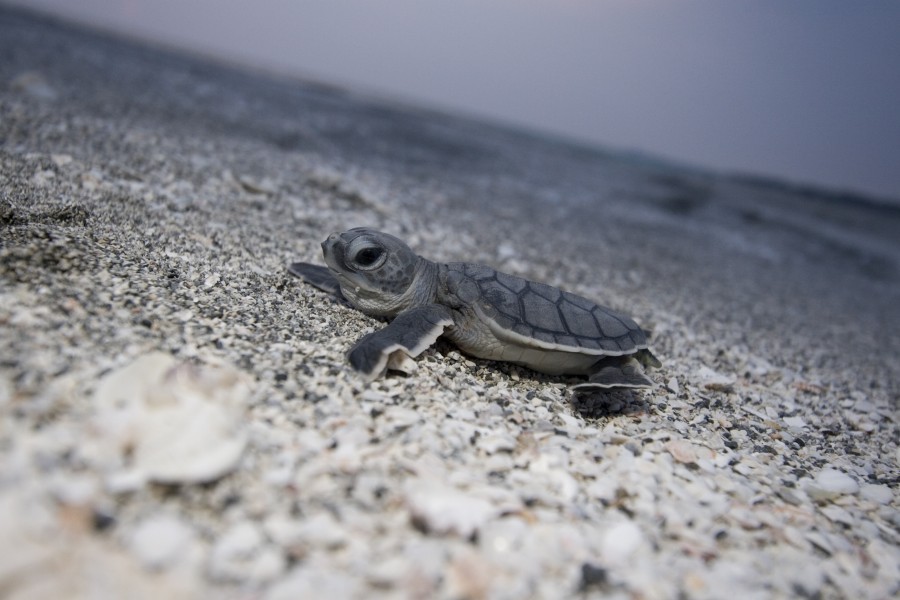Turtle nesting breaks records along Longboat through Venice
Sea turtles have finished nesting on local beaches and Mote Marine Laboratory scientists are happy to announce that 2015 was a record breaking season for sea turtle nests along Mote-monitored beaches from Longboat Key through Venice.
Mote's Sea Turtle Conservation and Research Program has coordinated conservation of endangered sea turtles along 35 miles of Sarasota County beaches for the past 34 years.
Mote’s multi-decade monitoring efforts provide data that resource managers can use to understand and protect sea turtle populations. Long-term data are particularly important because sea turtles are long-lived species. It takes about 30 years for hatchlings born on our beaches to return to nest as adults.
Following a thorough review of data once sea turtle nesting season officially concluded on Oct. 31, Mote’s Sea Turtle Patrol — a group of scientists, interns and volunteers who have monitored nesting beaches for 34 years — report that a confirmed total number of nests along Longboat Key through Venice reached 2,475 nests in 2015, which beats the 2012 record by 6 nests.
Out of those nests, 340 were laid along Longboat Key Manatee County, beating its previous 2013 record of 327 nests; 698 nests were laid along the entirety of Longboat Key, beating its 2013 record of 643 nests; 408 nests were laid along Siesta Key, beating its 1995 record of 343 nests; and a total of 36 green sea turtle nests were laid along the 35 mile stretch of beaches, which broke Mote’s previous record of 30 green turtle nests in 2013.
These all-time high records since the inception of Mote’s Sea Turtle Patrol 34-years ago signify the need for conservation support and the time is now. Funding for supplies and operating costs will be in high demand following the highly successful nesting season and projections for more even more successful years to come.
“This year was such an incredibly successful year for sea turtle nesting numbers, which is great to see as these animals are endangered,” said Kristen Mazzarella, senior biologist with Mote’s Sea Turtle Conservation and Research Program. “As we start to see nesting numbers increase, we know communicating the urgency of conservation efforts for future generations is vital now more than ever before. It's exciting to consider how our local research, conservation and education efforts here at Mote may be helping with this positive change.”
How to Help Sea Turtles
Support sea turtle conservation and research.
Mote scientists are seeking donations of supplies and funding to help support the Sea Turtle Patrol as they prepare for another busy year in 2016.
To make a donation, visit www.mote.org/support, click "Donations" and choose to donate to Mote's operating fund. During the checkout, enter “Sea Turtle Conservation and Research” in the box marked “donor notes.”
To make an in-kind donation of supplies, please contact Kathy Klingensmith at 941-388-4441, ext. 308 or kak@mote.org.
Supplies needed to gear up for the 2016 turtle nesting season include:
- Black permanent markers from Sharpie
- 100-foot large measuring tapes with non-metal blades
- Paint roller covers, 9-inch and 4-inch (for painting yellow stakes to mark nests)
- Flagging tape (for marking nests)
- Latex gloves, medium size (for excavating hatched nests to document their contents)
- Rubber mallets (for pounding stakes into the sand to mark nests)
- Handheld GPS units (for documenting locations of turtle activities)
- Digital cameras (for documenting nests and turtle crawls)
- All-terrain vehicle covers (for ATVs used to patrol beaches)
- Yellow paint, 5-gallon cans (for painting stakes to mark nests)
- Large tarps (used when painting nest stakes)
- WD-40 lubricant (1 gallon)
- AAA and AA batteries (for GPS and cameras used to document nests)
- Waterproof field notebooks (from “Rite in the Rain” brand)
- Red LED headlamps (for monitoring and studying sea turtles at night on the beach – red light does not disturb nesting turtles or hatchlings)
- Wire cutters for making and disassembling protective cages
To help support Mote Marine Laboratory’s Sea Turtle Conservation and Research Program, visit https://mote.org/support/donate
